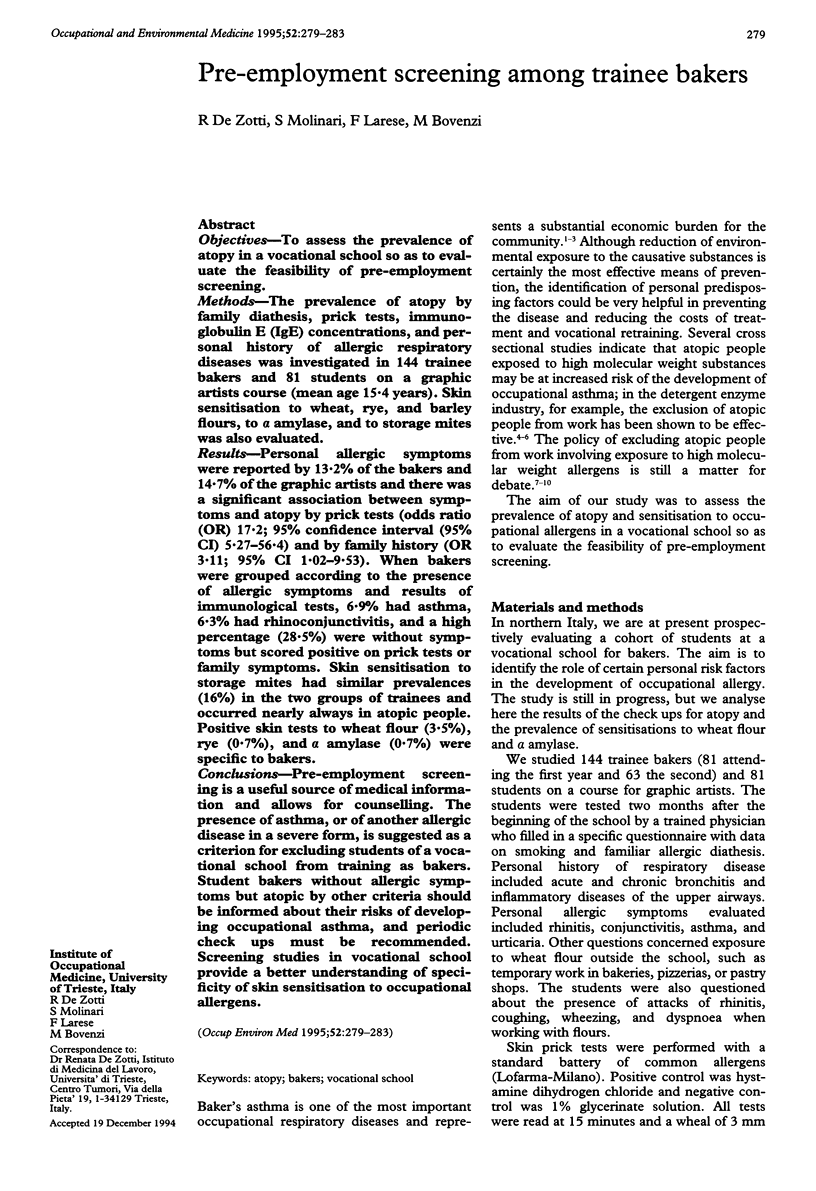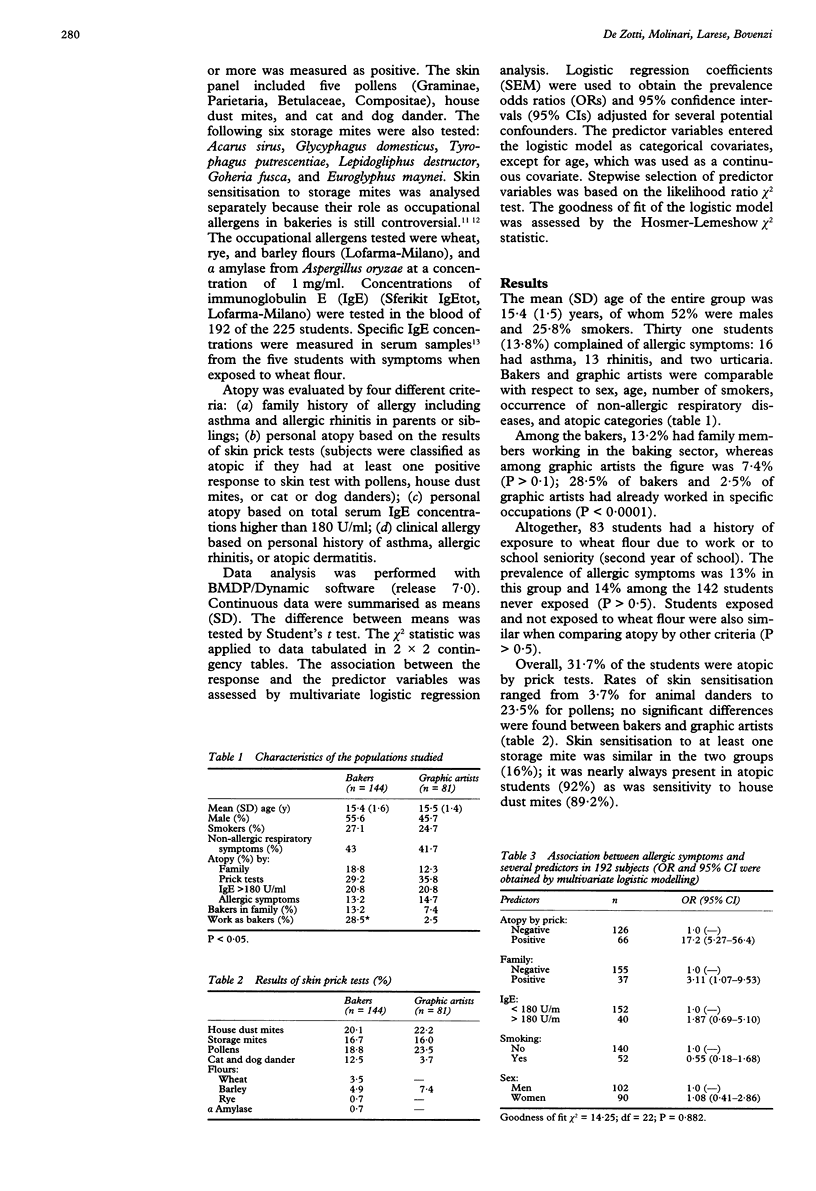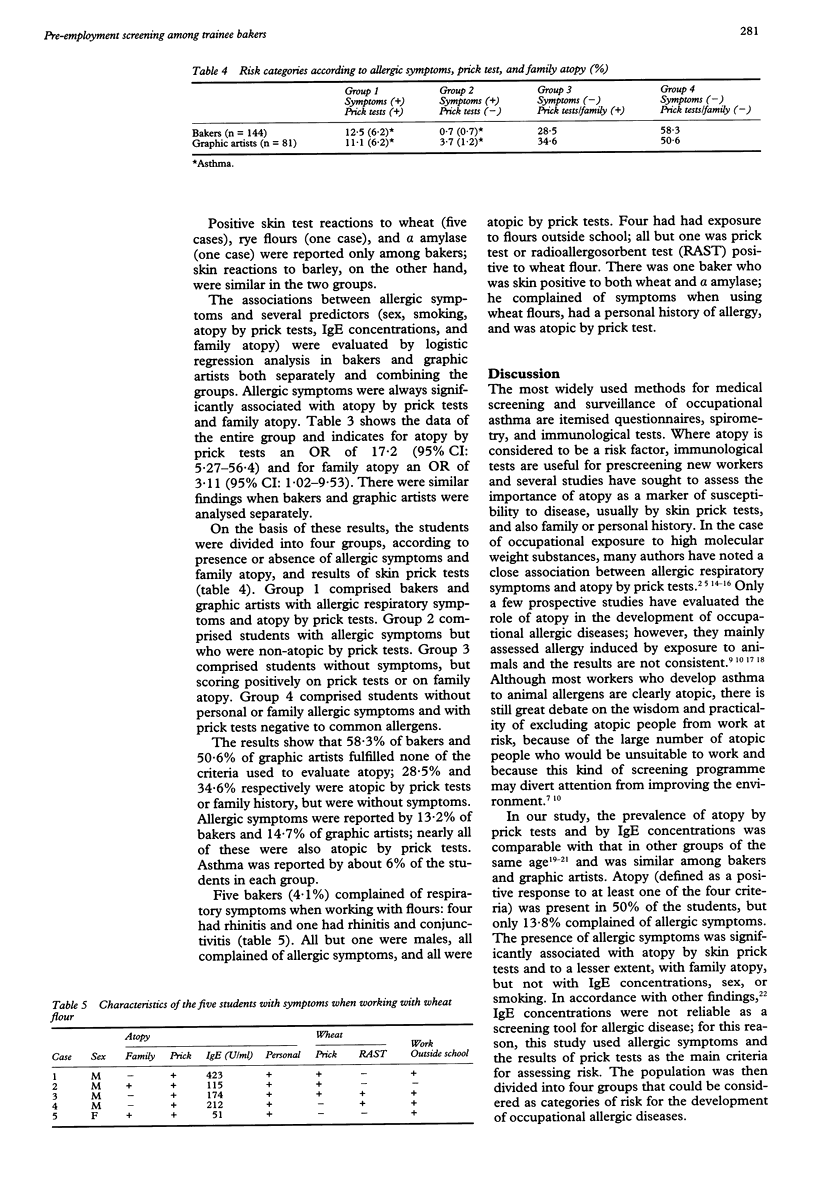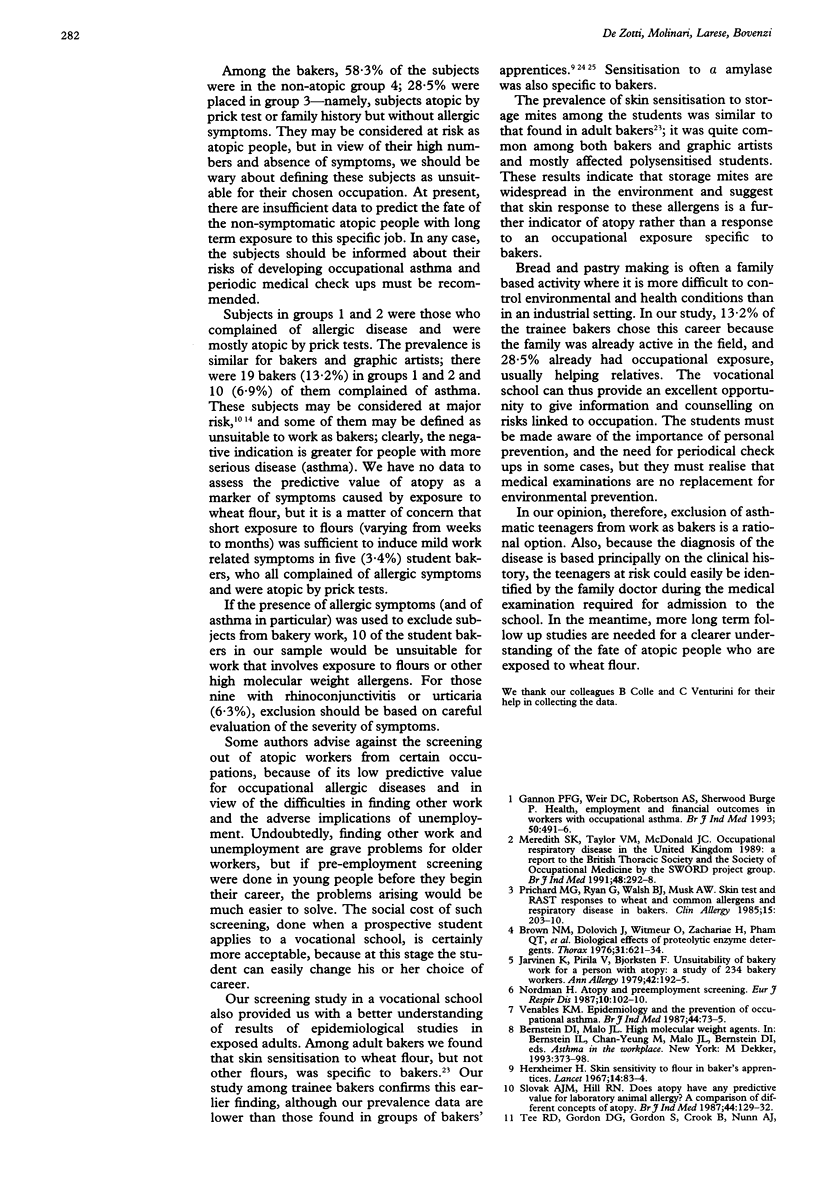Abstract
OBJECTIVES--To assess the prevalence of atopy in a vocational school so as to evaluate the feasibility of pre-employment screening. METHODS--The prevalence of atopy by family diathesis, prick tests, immunoglobulin E (IgE) concentrations, and personal history of allergic respiratory diseases was investigated in 144 trainee bakers and 81 students on a graphic artists course (mean age 15.4 years). Skin sensitisation to wheat, rye, and barley flours, to alpha amylase, and to storage mites was also evaluated. RESULTS--Personal allergic symptoms were reported by 13.2% of the bakers and 14.7% of the graphic artists and there was a significant association between symptoms and atopy by prick tests (odds ratio (OR) 17.2; 95% confidence interval (95% CI) 5.27-56.4) and by family history (OR 3.11; 95% CI 1.02-9.53). When bakers were grouped according to the presence of allergic symptoms and results of immunological tests, 6.9% had asthma, 6.3% had rhinoconjunctivitis, and a high percentage (28.5%) were without symptoms but scored positive on prick tests or family symptoms. Skin sensitisation to storage mites had similar prevalences (16%) in the two groups of trainees and occurred nearly always in atopic people. Positive skin tests to wheat flour (3.5%), rye (0.7%), and alpha amylase (0.7%) were specific to bakers. CONCLUSIONS--Pre-employment screening is a useful source of medical information and allows for counseling. The presence of asthma, or of another allergic disease in a severe form, is suggested as a criterion for excluding students of a vocational school from training as bakers. Student bakers without allergic symptoms but atopic by other criteria should be informed about their risks of developing occupational asthma, and periodic check ups must be recommended. Screening studies in vocational school provide a better understanding of specificity of skin sensitisation to occupational allergens.
Full text
PDF




Selected References
These references are in PubMed. This may not be the complete list of references from this article.
- Aoyama K., Ueda A., Manda F., Matsushita T., Ueda T., Yamauchi C. Allergy to laboratory animals: an epidemiological study. Br J Ind Med. 1992 Jan;49(1):41–47. doi: 10.1136/oem.49.1.41. [DOI] [PMC free article] [PubMed] [Google Scholar]
- Backer V., Ulrik C. S., Wendelboe D., Bach-Mortensen N., Hansen K. K., Laursen E. M., Dirksen A. Distribution of serum IgE in children and adolescents aged 7 to 16 years in Copenhagen, in relation to factors of importance. Allergy. 1992 Oct;47(5):484–489. doi: 10.1111/j.1398-9995.1992.tb00669.x. [DOI] [PubMed] [Google Scholar]
- Biological effects of proteolytic enzyme detergents. Thorax. 1976 Dec;31(6):621–634. doi: 10.1136/thx.31.6.621. [DOI] [PMC free article] [PubMed] [Google Scholar]
- Botham P. A., Davies G. E., Teasdale E. L. Allergy to laboratory animals: a prospective study of its incidence and of the influence of atopy on its development. Br J Ind Med. 1987 Sep;44(9):627–632. doi: 10.1136/oem.44.9.627. [DOI] [PMC free article] [PubMed] [Google Scholar]
- Burge P. S., Edge G., O'Brien I. M., Harries M. G., Hawkins R., Pepys J. Occupational asthma in a research centre breeding locusts. Clin Allergy. 1980 Jul;10(4):355–363. doi: 10.1111/j.1365-2222.1980.tb02119.x. [DOI] [PubMed] [Google Scholar]
- Chan-Yeung M., Vedal S., Lam S., Enarson D. Immediate skin reactivity and its relationship to age, sex, smoking, and occupational exposure. Arch Environ Health. 1985 Jan-Feb;40(1):53–57. doi: 10.1080/00039896.1985.10545889. [DOI] [PubMed] [Google Scholar]
- De Zotti R., Larese F., Bovenzi M., Negro C., Molinari S. Allergic airway disease in Italian bakers and pastry makers. Occup Environ Med. 1994 Aug;51(8):548–552. doi: 10.1136/oem.51.8.548. [DOI] [PMC free article] [PubMed] [Google Scholar]
- Gannon P. F., Weir D. C., Robertson A. S., Burge P. S. Health, employment, and financial outcomes in workers with occupational asthma. Br J Ind Med. 1993 Jun;50(6):491–496. doi: 10.1136/oem.50.6.491. [DOI] [PMC free article] [PubMed] [Google Scholar]
- Herxheimer H. Skin sensitivity to flour in bakers' apprentices. Lancet. 1967 Jan 14;1(7481):83–84. doi: 10.1016/s0140-6736(67)92479-8. [DOI] [PubMed] [Google Scholar]
- Huguenot C., Zellweger J. P., Pécoud A., Droz P. O., Boillat M. A. Approche multidisciplinaire de l'asthme des boulangers. Schweiz Rundsch Med Prax. 1987 Aug 25;76(35):954–957. [PubMed] [Google Scholar]
- Järvinen K. A., Pirilä V., Björksten F., Keskinen H., Lehtinen M., Stubb S. Unsuitability of bakery work for a person with atopy: a study of 234 bakery workers. Ann Allergy. 1979 Mar;42(3):192–195. [PubMed] [Google Scholar]
- Kibby T., Powell G., Cromer J. Allergy to laboratory animals: a prospective and cross-sectional study. J Occup Med. 1989 Oct;31(10):842–846. doi: 10.1097/00043764-198910000-00010. [DOI] [PubMed] [Google Scholar]
- Lindberg R. E., Arroyave C. Levels of IgE in serum from normal children and allergic children as measured by an enzyme immunoassay. J Allergy Clin Immunol. 1986 Oct;78(4 Pt 1):614–618. doi: 10.1016/0091-6749(86)90078-3. [DOI] [PubMed] [Google Scholar]
- Meredith S. K., Taylor V. M., McDonald J. C. Occupational respiratory disease in the United Kingdom 1989: a report to the British Thoracic Society and the Society of Occupational Medicine by the SWORD project group. Br J Ind Med. 1991 May;48(5):292–298. doi: 10.1136/oem.48.5.292. [DOI] [PMC free article] [PubMed] [Google Scholar]
- Nielsen N. H., Svendsen U. G., Madsen F., Dirksen A. Allergen skin test reactivity in an unselected Danish population. The Glostrup Allergy Study, Denmark. Allergy. 1994 Feb;49(2):86–91. doi: 10.1111/j.1398-9995.1994.tb00805.x. [DOI] [PubMed] [Google Scholar]
- Nordman H. Atopy and preemployment screening. Eur J Respir Dis Suppl. 1987;154:102–110. [PubMed] [Google Scholar]
- Popp W., Wagner C., Kiss D., Zwick H., Sertl K. Prediction of sensitization to flour allergens. Allergy. 1994 May;49(5):376–379. doi: 10.1111/j.1398-9995.1994.tb02285.x. [DOI] [PubMed] [Google Scholar]
- Prichard M. G., Ryan G., Walsh B. J., Musk A. W. Skin test and RAST responses to wheat and common allergens and respiratory disease in bakers. Clin Allergy. 1985 Mar;15(2):203–210. doi: 10.1111/j.1365-2222.1985.tb02274.x. [DOI] [PubMed] [Google Scholar]
- Revsbech P., Dueholm M. Storage mite allergy among bakers. Allergy. 1990 Apr;45(3):204–208. doi: 10.1111/j.1398-9995.1990.tb00484.x. [DOI] [PubMed] [Google Scholar]
- Sjöstedt L., Willers S. Predisposing factors in laboratory animal allergy: a study of atopy and environmental factors. Am J Ind Med. 1989;16(2):199–208. doi: 10.1002/ajim.4700160211. [DOI] [PubMed] [Google Scholar]
- Slovak A. J., Hill R. N. Does atopy have any predictive value for laboratory animal allergy? A comparison of different concepts of atopy. Br J Ind Med. 1987 Feb;44(2):129–132. doi: 10.1136/oem.44.2.129. [DOI] [PMC free article] [PubMed] [Google Scholar]
- Tee R. D., Gordon D. J., Gordon S., Crook B., Nunn A. J., Musk A. W., Venables K. M., Taylor A. J. Immune response to flour and dust mites in a United Kingdom bakery. Br J Ind Med. 1992 Aug;49(8):581–587. doi: 10.1136/oem.49.8.581. [DOI] [PMC free article] [PubMed] [Google Scholar]
- Venables K. M. Epidemiology and the prevention of occupational asthma. Br J Ind Med. 1987 Feb;44(2):73–75. doi: 10.1136/oem.44.2.73. [DOI] [PMC free article] [PubMed] [Google Scholar]


